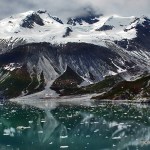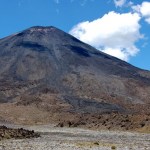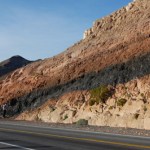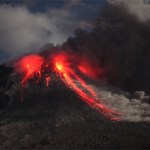Alaska
I read an interesting article in the Alaska Dispatch News which examined interactions between arctic grizzly bears and polar bears. They found that although polar bears are larger, they tend to leave food sources when grizzly bears are around. This may be because polar bears typically spend a lot of time on sea ice without the need to be aggressive towards competitors. Of concern is that the relatively passive nature of polar bears may be detrimental considering these animals are increasingly spending more time foraging on land during the summer and fall months.…
Alaska is being called the poster child (state?) for climate change because things have been so strange there lately. One reason for this is the extreme warm conditions in the North Pacific and associated (probably) changes in the jet stream, as well as overall warming, which has caused coastal Alaska to become a warm place, glaciers to melt, and (in the farther north) sea ice to be less. And now, President Obama has made a trip there and given a big speech.
President Obama's speech:
https://www.youtube.com/watch?v=FvIrlaXU28A
More information on the President's trip here.
Meanwhile,…
Some remarkable weather in North America recently as most of you probably know. Check out Jeff Masters for some of the details.
Record warmth and precipitation in Alaska
As of January 26, 13.83" of precipitation had fallen in Valdez during the month of January. This is more than 8" above average for this point in the month, and close to the all-time record for January precipitation of 15.18", set in 2001 (records go back to 1972.) With more rain on the way Monday and Tuesday, this record could easily fall. Numerous locations in Southeast Alaska have beaten their rainiest January day on…
I had heard it was warm in Alaska, but holy moly, I didn't know it was THIS warm. Above is an anomaly map showing the Drunken Arctic Air in central and eastern Canada and the US in contrast with the very (relatively) warm air over western Canada and Alaska. Remember, these are anomalies, not absolute temperatures. But still, it is warm enough in at least parts of Alaska that lakes that are normally well frozen by now are not frozen at all and may not even freeze this winter.
Here are photographs taken by A.M.Mueller on January 25th 2014 in Skilak Lake, Kenai Peninsula, Alaska, and passed…
News for Monday!
Ngauruhoe in New Zealand, showing the dark lava flows of basaltic andesite on the slopes of the young volcanic cone. Image by Erik Klemetti, taken January 2009.
A couple pieces of news from two Russian volcanoes on the Kamchatka Peninsula: (1) last week's report of activity at Gorely appears to be semi-substantiated with new photos on the KVERT website (Russian). The images from June 6 and 12 (2010) shows steam plumes coming from the volcano - one as tall as 500 meters. Now, this doesn't imply that an eruption occurred, but it might suggest activity on on the upswing. KVERT…
The NASA Earth Observatory has been dazzling us with images from the Eyjafjallajökull eruption for months - but they have been dazzling us with volcanoes images for years! Here are two more images for those of you who love seeing volcanoes from above:
Cleveland, Alaska
As I mentioned earlier this week, Cleveland volcano likely had a small eruption over the weekend producing a small ash cloud. Cleveland is already known as an extremely picturesque volcano, both from the ground for its highly conical shape - a textbook andesitic stratocone - and from space. This new June 1 image is from almost…
Tungurahua in Ecuador erupting on May 31, 2010.
Two volcanoes along the edge of the north Pacific had explosive eruptions over the weekend. We have some more details on both of the eruptions, so I'll pass them on:
Bezymianny
KVERT is excited because they claim to have predicted the explosive eruption of Bezymianny almost to the day. They had been closely monitoring the volcano and issued this statement on May 20:
According to satellite data by AVO and KVERT staff, a temperature of
the thermal anomaly over the lava dome of Bezymianny volcano began
increasing from May 19 (from -1 (9:49 UTC) to…
Brief news!
Lava flows reaching the sea at Kilauea in Hawai`i. Image from November 2009, courtesy of HVO/USGS.
The Alert Status at Cleveland in the Alaskan Aleutian Islands was raised to Yellow (Advisory) by the Alaska Volcano Observatory after new signs of activity emerged. The latest report from AVO on the volcano says a thermal anomaly has been spotted at the summit, which typically is one of the first signs that the volcano is entering an eruption period. However, there is no real-time seismic monitoring for Cleveland, so that is the only clue (right now) that AVO has. Cleveland is a…
Hard to believe, but there is other volcano-related news in the world ...
So, with all deference to Eyjafjallajokull, here it is:
Dome collapse on Colima in Mexico, image taken March 30, 2010.
The new Smithsonian/USGS GVP Weekly Volcano Activity Report was issued, with news about increasing signs of activity at Egon in Indonesia, a possible plume at Miyakejima in Japan and more dome growth at Soufriere Hills.
A study on the economic effect of a new Vesuvius eruption was released and the finding show the potential for a staggering $24 billion of economic damage directly related to an…
Lots to do!
Tourists flock to the Eyjafjallajökull-Fimmvörduháls in Iceland.
The media does love the term "supervolcano", and a number of Eruptions readers sent me a link to the article on the dreaded submarine "supervolcanoes". I would delve into this article from Live Science, but it sadly again does a dreadful job with a lot of this - remember, "supervolcano" is a made-up word by the BBC with no strict definition, so trying to say there are a dozen supervolcanoes worldwide is just silly. And why does it take multiple paragraphs and multiple mentions of "scientists" before they get a…
The steam plume from the new dome on Redoubt, taken in January 2010. Image courtesy of USGS/AVO, taken by Dennis Anderson.
News comes out of Alaska that a small earthquake swarm has begun under Redoubt. This is the second such swarm since the volcano's 2009 activity ceased. Most of the seismicity appears to be near the summit of the volcano, which would suggest that magma might be moving underneath the new dome that is still steaming.
AVO describes the unrest:
"This morning, at roughly 01:44 AKDT (0944 UTC) a series of small repetitive earthquakes began occurring in the vicinity of the…
I'm still playing catch-up after my week in the desert, so I've seen a lot of articles I've wanted to mention ... but a certain other volcano has taken up a lot of my time. However, I will attempt to make amends for that now.
By the way, would you believe Ubehebe Crater was closed? How do they close a volcano, anyway? However, I did get a great snap of a welded tuff on the road outside of Shoshone, CA.
A strongly welded tuff near Shoshone, CA. The dark interior is remelted volcanic ash/tephra surrounded by less welded pink tuff with abundant pumice clasts. Denison student David Sisak is on…
A muskox (Ovibos moschatus), photographed in Alaska. From Flickr user drurydrama.
Of all the mass extinctions that have occurred during earth's history, among the most hotly debated is the one which wiped out mammoths, saber-toothed cats, giant ground sloths, and the other peculiar members of the Pleistocene megafauna around 12,000 years ago. It was not the most severe mass extinction, not by a long shot, but unlike the end-Cretaceous catastrophe 65 million years ago there is no single "smoking gun" that can account for the pattern of extinction. Instead the Pleistocene mass extinction…
Did I mention its a busy week?
The lava lake at Erta'Ale in 2008. Image courtesy of Stromboli Online.
Our Icelandic saga continues, with more earthquakes and more speculation/information on the parts of Eruptions readers. Keep up the discussion - I'll be fascinated to see who turns out to get closest to what actually happens, prediction-wise. The seismicity has quieted somewhat again in the last 12 hours, so we wait eagerly to see what comes next. Remember, Iceland is the land where volcanoes helped change history, so it is always fun to talk Icelandic volcanism.
The NASA Earth Observatory…
Catching up with some news:
Anatahan erupting in the northern Mariana Islands in 2003.
I ran across this article right before I got sick, but its been popping up around the interwebs (and is pretty interesting). It details a study in Molecular Ecology that suggests that populations of caribou in Canada's Yukon Territory were strongly effected by the White River Tephra. The White River Tephra is supposedly the largest Holocene plinian tephra (from a ash cloud fallout), with two components dating from ~1900 years ago and ~1250 years ago. The vent for the WRT is likely from a vent beneath the…
Not a lot of big news, but a lot of little news:
Soufriere Hills at night during the late January 2010 dome growth episode. Note the hot rock falls from the collapsing dome. Image courtesy of Photovolcanica.
This might not be new, but Dr. Boris Behncke brought the new webcam at the rim of Chaiten in Chile to my attention. You get a birds-eye view of the growing dome from the edge of the caldera - pretty nifty view for a once-in-a-hundred-years sort of event.
The NASA Earth Observatory has posted a close-up of the Soufriere Hills imagethat I posted yesterday, showing the February 11 plume.…
Some news for the last Friday in January:
Volcanic lightning captured over Redoubt in March 2009.
Tungurahua in Ecuador continues to erupt. Yesterday, the volcano spread ash over much of central Ecuador. Apparently people in Ecuador aren't taking the hazard of ash too seriously, with many ignoring recommendations to wear masks when the ash is falling. Over 50 explosions have been recorded over the last 24 hours at the volcano according to the Ecuadorian Instituto GeofÃsico, most of them small to moderate.
We also have a new USGS/Smithsonian Institute Volcano Activity Report. Much of the "…
A pile of news for the new week!
The glow of new lava flows from Nyamuragira in the Congo, taken from the Virunga Park Headquarters, January 2, 2010.
Mayon
PHIVOLCS may lower the alert status at Mayon to Level 2 after almost a week of lower seismicity and no ash explosions since December 29th. Schools that were being used as evacuation centers were also returned to teachers and students for the start of classes after the Christmas holiday. However, the Albay provincial government is now considering a plan to permanently move everyone who lives within the 6-km danger zone around Mayon, even…
2009 is over! If you missed the Volcanic Year in Review, check out my summary of the volcanic events that captivated many of us over the past year. However, only one event will get the coveted 2009 Pliny for Volcanic Event of the Year. A lot of you wrote in with votes and comments - I thank you - and a number of events stood out in your mind. Here we go:
Honorable mention
A few volcanic events got multiple votes:
- Soufriere Hills on Montserrat.
- Mando Hararo in Ethiopia.
- Chaiten, Chile and the new research on the eruption.
- The earthquakes in western Saudi Arabia under the Harrat…
Here it is, my attempt to recap a year's worth of volcanic events. By no means is this supposed to capture every event, but rather the highlight/lowlights and what most captivated me during 2009. I'll be announcing the winner of the 2009 Pliny for Volcanic Event of the Year tomorrow.
Waimangu Geothermal Valley in New Zealand, taken in January 2009 by Erik Klemetti.
January
The year started out with a trip to New Zealand (well, for me at least) and vistas of the Waimangu Valley, formed in the 1886 eruption of Tarawera on the North Island. We were also still thinking about the late 2008…




